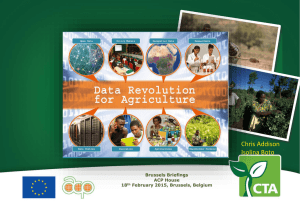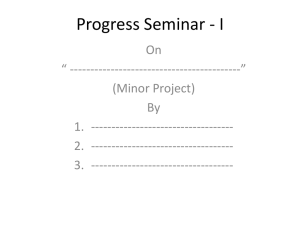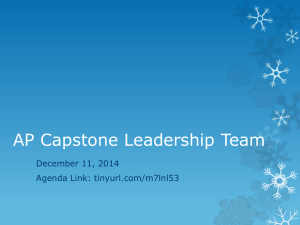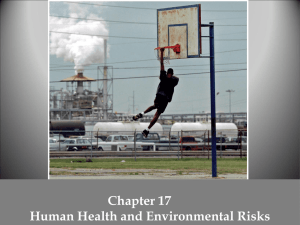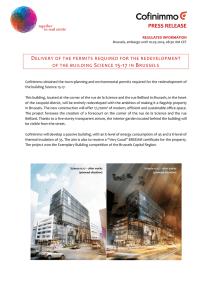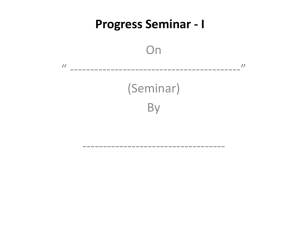Threshold vs non-threshold carcinogens, A. Huici-Montagud
advertisement
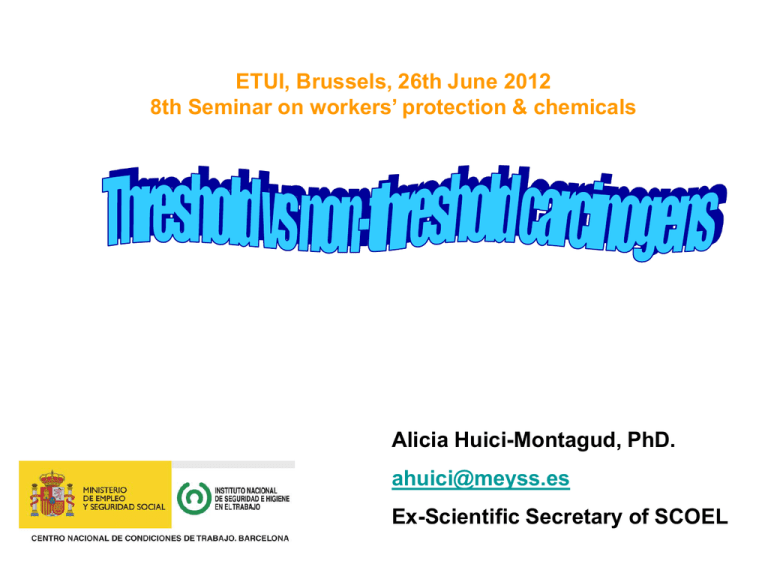
ETUI, Brussels, 26th June 2012 8th Seminar on workers’ protection & chemicals Alicia Huici-Montagud, PhD. ahuici@meyss.es Ex-Scientific Secretary of SCOEL ETUI, Brussels, 26th June 2012 8th Seminar on workers’ protection & chemicals CHEMICAL RISKS Regulation (CE) REACH Nr. 1907/2006 of the European Parlament and Council of the 18th of December 2006. Registration, Evaluation, Authorisation and Restriction of chemicals in the EU. Framework Directive D 89/391/CE and derived: D 98/24/CE and D 2004/37/CE (CAD) Requeriments in relation to health and safety at the workplace (OSH) en la UE Direct enforcement in MS National trasposition Mandatory TOGETHER: CARE FOR workers , consumers and environment. ETUI, Brussels, 26th June 2012 8th Seminar on workers’ protection & chemicals Two ways to establish limit values • D 98/24/CE on chemical agents (indicative and binding values) • D 2004/37/CE on carcinogens and mutagens (only binding) - IOELVs : Based on health criteria, derived from the assessment of updated and validated scientific data Below this exposure no adverse effects are expected. - BOELVs : Also consider practical and socio-economical factors and the risk accepted by society They are considered “political-type” values*. * Political decision: to define “acceptable” versus “non-acceptable” risk ETUI, Brussels, 26th June 2012 8th Seminar on workers’ protection & chemicals Art. 3 CAD: “An independent scientific evaluation by the EC” •EU-wide acceptance and implementation •Representativeness and transparency •EU IOELs provide a certain amount of flexibility to the MSs when introducing national OELs. ETUI, Brussels, 26th June 2012 8th Seminar on workers’ protection & chemicals A. Forbidden zone (Risk is unacceptable) BOEL B. Grey zone (Risk exists and should be eliminated or reduced to a minimum) Health effects and risks are proportional to the occupational exposure 1a. What is the maximum acceptable risk by the society? 1b. At which level should it be placed? 2. Feasibility factors. 3. Socio-economic considerations. IOELV C. Safe zone ( Risk does not exist-No health effects expected) ETUI, Brussels, 26th June 2012 8th Seminar on workers’ protection & chemicals Evolution of SCOEL’s methodology (January 1990-July 2011) http://ec.europa.eu/social/main.jsp?catId=153&langId=en&intPageId= 684 right menu: related documents ETUI, Brussels, 26th June 2012 8th Seminar on workers’ protection & chemicals • Multistep, multifactorial changes ETUI, Brussels, 26th June 2012 8th Seminar on workers’ protection & chemicals The sistematic process of neoplastic development Initiation Mutagenic NO THRESHOLD Promotion Mec. ≠ DNA/protein union THRESHOLDED ETUI, Brussels, 26th June 2012 8th Seminar on workers’ protection & chemicals e.g. METALS Weak mutagens; often inactive in STT Some species: direct intercalation in DNA and histones (e.g; Pt, Au) Some species: clastogenic activity, indirect mechanisms Main putative mechanisms: Induction of oxidative stress (ROS) Inhibition of DNA repair Deregulation of cell proliferation Relevance in vivo? ETUI, Brussels, 26th June 2012 8th Seminar on workers’ protection & chemicals Interactions with the cell cycle CdK (keeping cycle) Cicline B (entering mitosis) APC ligase (separation SC) Level of CdK (end of mitosis) Keeping G1 ETUI, Brussels, 26th June 2012 8th Seminar on workers’ protection & chemicals Actions of Metal Compounds Inhibition of DNA repair Inhibition of antioxidant defences Activation of mitotic signalling Modulation of gene expression From: Beyersmann & Hartwig Arch Toxicol (2008) 82: 493-512 Genomic Instability Oxidative stress Accumulation of critical mutations Deregulation of cell proliferations Induction of protooncogenes Inactivation of tumour suppressor genes TU MO R ETUI, Brussels, 26th June 2012 8th Seminar on workers’ protection & chemicals SCOEL approach for setting OELs for carcinogens ETUI, Brussels, 26th June 2012 8th Seminar on workers’ protection & chemicals A: Non-threshold genotoxic carcinogens reactive and iniciating chemicals (linear extrapolation) ej. Some PLATINUM SALTS, VINYL CHLORIDE, 1,3-BUTADIENE, METHYLENE DIANILINE, DIMETHYL SULPHATE ALARA B: Genotoxic carcinogens for which a threshold cannot be sufficiently supported at present. (LNT by default, based on scientific uncertainty) ej. HEXAVALENT CHROMIUM COMPOUNDS, BENZENE, WOOD DUST, BERYLLIUM ? C: Genotoxic carcinogens with a practical threshold, as supported by studies on mechanisms and /or toxicokinetics; OELs are health-based and a NOAEL can be established. Acting through dose-mediated mechanisms ej. NICKEL, CADMIUM, VINYL ACETATE, FORMALDEHYDE, NITROBENZENE, PYRIDINE, SILICA, NAPHTALENE D: Non-genotoxic carcinogens and non-DNA reactive carcinogens. Clearly founded NOAEL Dose-dependent carcinogens (e.g. promoters, aneugens, topoisomerase inhibitors,hormones) ej. CHLOROPHORM, PHENOL, CARBON TETRACHLORIDE (Bolt & Huici; Arch Toxicol. 2008 Jan;82(1):61-4) ETUI, Brussels, 26th June 2012 8th Seminar on workers’ protection & chemicals SCOEL GROUP A: Genotoxic compound with no threshold 1,3-Butadiene: Evidence: to be treated as a possible human carcinogen, operating via a genotoxic mechanism. Hence, according to the established approach for such carcinogenic substances, the excess risk [for leukaemia] entailed in exposure during a working life to various concentrations of butadiene has been calculated using various models (tables attached). Recommendation: “In a population of 1.000 adult males experiencing a mortality rate similar to that of the male population of England and Wales, occupational exposure to 1 ppm of 1,3-butadiene for a working life (40 years between the ages of 25 and 65), will cause from 0.0 to 10.78 extra leukaemia deaths between the ages 25-85 years, in addition to the 5 leukaemia deaths expected to occur in the absence of exposure to 1,3-butadiene.” ETUI, Brussels, 26th June 2012 8th Seminar on workers’ protection & chemicals SCOEL GROUP B: Genotoxic compound with unknown threshold so far Hexavalent chromium compounds: Excess lung cancers x 103 Working lifetime exposure 5-28 50 µg/m3 2-14 25 µg/m3 1-6 10 µg/m3 0.5-3 5 µg/m3 0.1-0.6 1 µg/m3 ETUI, Brussels, 26th June 2012 8th Seminar on workers’ protection & chemicals SCOEL GROUP C: Practical threshold likely Formaldehyde: Weak genotoxic carcinogen, for which avoidance of cell proliferation is deemed to avoid carcinogenic potential NOAEL: 3 ppm OEL: 2 ppm ETUI, Brussels, 26th June 2012 8th Seminar on workers’ protection & chemicals SCOEL GROUP D: Non- Genotoxic carcinogen Carbon tetrachloride: Evidence: predominantly negative genotoxicity data and the specificity of carcinogenicity, it is considered that the tumours observed in carbon tetrachloridetreated animals are associated with chronic tissue damage. Thus, carbon tetrachloride is not likely to be carcinogenic under occupational exposure conditions providing protection from toxicity. Recommendation: “From a study by Nagano 2007 SCOEL concludes that an airborne level 1 ppm carbon tetrachloride represents an established NOAEL for humans under industrial exposure conditions, which very likely also includes a further margin of safety. Hence, the recommended Occupational Exposure Limit (OEL; 8-hour TWA) is 1 ppm (6.4 mg/m3). In view of a report of increased serum enzymes in rats treated with 10 ppm (63 mg/m3) carbon tetrachloride for 1 h/d (McSheehy et al, 1984), a STEL (15 mins) of 5 ppm (32 mg/m3) can be proposed to limit peaks of exposure which could result in hepatotoxicity. “
